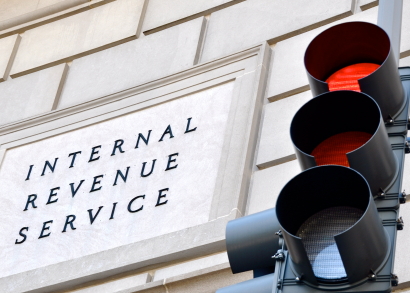
GAO report claims the IRS could significantly increase revenues with better enforcement.
As taxes and budget deficits continue to dominate the legislative agenda in Washington, D.C., a recent Government Accountability Office (GAO) report suggests the government could raise additional revenues by reallocating enforcement resources.
With mounting political support for deficit reduction, the Internal Revenue Service (IRS) has faced increasing pressure to reduce the “tax gap”—the difference between the taxes legally owed and the amount the agency collects on a timely basis.
The tax gap is apparently rising. The IRS recently estimated a 2006 tax gap of $450 billion, of which the agency expects to collect only $65 billion through late payments and enforcement actions. In 2006, the IRS estimated that the 2001 tax gap was $345 billion. The IRS claims that this rise is likely a result of total increases in tax liability rather than a change in taxpayer compliance rates.
The tax gap’s lost revenues have garnered significant attention. In a biannual report to Congress released this January, Nina Olson, the National Taxpayer Advocate, who serves as an advocate to the IRS and Congress on behalf of taxpayers, describes how IRS “chronic underfunding” is “one of the most significant long-term risks to tax administration,” undermining the agency’s communications with taxpayers and reducing revenue collection. Olson describes the IRS as “the federal government’s accounts receivable department” and she advocates excluding the IRS from spending ceilings because the IRS generates revenue for every dollar it spends.
Similarly, a recent report by the Center for American Progress argued that to address both intentional tax evasion as well as unintentional underpayment, both of which contribute to the tax gap, IRS capacity should be expanded to enhance tax enforcement.
Even without increasing IRS funding, the GAO’s recent report may offer a method of decreasing the tax gap by reallocating IRS enforcement resources. Based on a review of IRS examinations during 2007 and 2008, the GAO determined that the IRS could “significantly increase” revenues by shifting its enforcement resources from field examinations to the examination of individual tax returns through correspondence.
Correspondence examinations are formal audits of individual tax returns that do not involve face-to-face meetings with taxpayers. They generally target compliance issues that are limited in scope and complexity so that the IRS can handle them quickly through correspondence with the filer. During the two-year period the GAO investigated, field and correspondence examinations together accounted for 80% of IRS enforcement resources.
In terms of direct revenue resulting from such examinations, the GAO found that correspondence examinations were “significantly more productive” than field examinations. Whereas field investigations cost an average of $2,278, correspondence exams cost an average of only $274. The GAO estimated that for every dollar spent conducting correspondence examinations, the average yield was $7, whereas the corresponding yield per dollar for field examinations was $1.80.
Given the disparity between these yields, the GAO projected that by shifting a small share of resources, about $124 million, to more productive examinations, the IRS could increase tax revenue by $1 billion per year. This figure is an almost 20% increase over the average amount the IRS actually collected in the years the GAO studied. The GAO measured the projections by hypothetically reallocating resources between different enforcement programs while considering constraints such as existing staff skills and the need for field examinations to target certain complex issues.
The GAO also emphasized that the IRS should continue to allocate enforcement resources towards higher income taxpayers. Of the IRS’s annual $1.6 billion exam budget for 2007 and 2008, the IRS spent nearly 20% examining returns belonging to taxpayers with “positive income” greater than $200,000, even though these returns account for only 3% of the individual returns filed during each of these years. “Positive income” is a measure used by the IRS when the agency examines tax returns that disregards losses that may offset this income.
The IRS determined that both correspondence and field examinations of taxpayers with incomes greater than $200,000 were more productive than exams of lower-income taxpayers. Targeting these high-bracket taxpayers is particularly notable given the small number of tax returns that the IRS actually reviews—the agency only audited 1.1% of the 141 million individual returns filed during 2010.
In its response to the GAO report, the IRS wrote that it agrees with the recommendation “in principle.” Nonetheless, the IRS criticized the GAO’s use of average direct revenues, rather than marginal revenues, when computing revenue-to-cost ratios for various compliance programs. In addition, the IRS emphasized difficulties in measuring the indirect consequences of shifting resources from correspondence to field examinations, such as the effects on voluntary compliance.
According to the IRS, developing meaningful estimates of marginal and indirect effects of reallocating resources is an ongoing challenge, so it will take years to improve data systems to measure these results. Until the IRS can collect such data, the agency claims it will “not have an acceptable empirical basis for making perfect judgments” by which to allocate resources.
The GAO report projects that reallocating enforcement resources would not reduce voluntary compliance with tax laws. Nonetheless, the GAO acknowledges that because correspondence and field examinations target different sorts of issues, reallocation may modify taxpayer choices in determining voluntary compliance. As a result, the GAO acknowledges that an uncertain degree of negative consequences may offset some positive consequences of shifting resource allocations.
Additionally, increasing enforcement and modifying enforcement strategies may affect complying as well as non-complying taxpayers. A 2007 paper by the Urban Institute’s Dr. Eric J. Toder, who served as a former deputy director of the U.S. Treasury Department’s Office of Tax Analysis, emphasized that tax enforcement imposes various costs on complying taxpayers. For instance, a complying taxpayer who is subject to an IRS audit may spend additional time meeting and corresponding with IRS agents and gathering records. A complying taxpayer may potentially incur costs of hiring private tax or legal experts because of reallocated IRS enforcement resources.
This report is not the first time in recent years that the GAO has emphasized the need for the IRS to improve its enforcement mechanisms. The GAO previously released a report in 2010 stating that the IRS could reduce the tax gap by reforming its data collection systems to enable the agency to select cases strategically for audit and further examination. Through these reports, the GAO signals that the IRS should enforce tax laws strategically if tax revenue is going to play a significant role in reducing the deficit.



